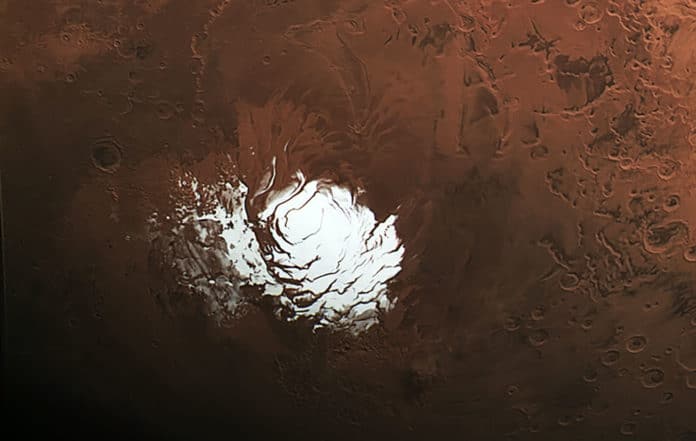In 2018, scientists observed bright radar reflections under the polar cap. At that time, scientists thought they were looking at liquid water. But, a new study of the red planet by the University of Texas at Austin suggests that those radar reflections are just a dusty mirage. The reflections matched volcanic plains found all over the red planet’s surface.
Based on new findings, scientists conclude that there is volcanic rock.
The study’s lead author, Cyril Grima, a planetary scientist at the University of Texas Institute for Geophysics (UTIG), said, “For water to be sustained this close to the surface, you need both a very salty environment and a strong, locally generated heat source, but that doesn’t match what we know of this region.”
When Grima added an imaginary global ice sheet across a radar map of Mars, the south polar mirage dissolved. The imaginary ice showed how Mars’ terrains would look when observed through a mile of ice. This allowed scientists to compare features across the entire planet with those under the polar cap.
They noticed bright reflections similar to those in the south pole but scattered across all latitudes. In as many, as could be confirmed, they matched the location of volcanic plains.
Grima said, “On Earth, iron-rich lava flows can leave behind rocks that similarly reflect radar. Other possibilities include mineral deposits in dried riverbeds. Either way, figuring out what they are could answer important questions about Mars’ history.”
“Although there may not be liquid water trapped under the southern polar cap, there is plenty of water ice on Mars, including in the thick polar caps. The new study hints at Mars’ wetter past.”
According to Isaac Smith, a Mars geophysicist at York University, those bright radar signatures are a kind of clay made when rock erodes in water.
He said, “I think the beauty of Grima’s finding is that while it knocks down the idea, there might be liquid water under the planet’s south pole today, it also gives us exact places to go look for evidence of ancient lakes and riverbeds and test hypotheses about the wider drying out of Mars’ climate over billions of years.”
Grima used three years of data from MARSIS to create the map. MARSIS was launched in 2005 aboard the European Space Agency’s Mars Express, has accumulated tremendous amounts of information about Mars.
Grima and Smith are now working on proposed missions to find water on Mars with radar.
NASA and CNES partially funded the study.
Journal Reference:
- C. Grima et al. The Basal Detectability of an Ice-Covered Mars by MARSIS. DOI: 10.1029/2021GL096518
